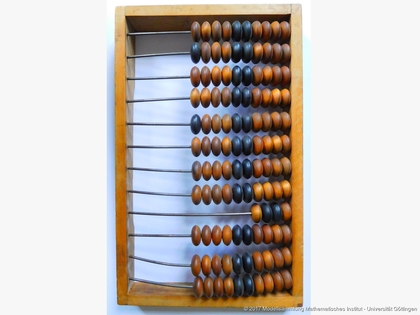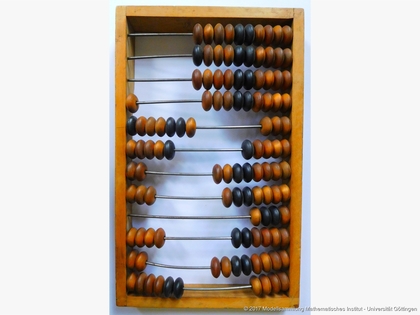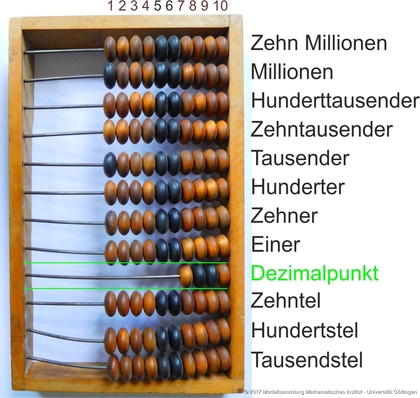Stschoty from russia
Model 487
Description
A stschoty is the russian version of the abacus. The object on display is an original from russa, it was donated to the collection by Karl-Heinz Volmer in 2017.
Additions
An abacus, a "counting frame" is a device used for adding and subtracting positive numbers. It consists of a frame that holds several rods which usually have ten pellets or beads on them. These beads are used to depict numbers, where each rod represents one decimal power. Therefore the range of depictable numbers is limited by the number of rods. Because abacuses were historically used to solve everyday additions and subtractions, the depictable numbers usually lie between hundredth and hundreds of thousands.
One advantage of using an abacus is the fact, that the result of a calculation can be read out immediately. Theoretically it is even possible to do other types of calculations with an abacus, e.g. multiplications, as long as they can be transformed into a series of additions and subtractions. For instance $3\cdot5$ can be written and calculated as $3+3+3+3+3$ or $5+5+5$. This way of doing multiplications gets elaborate very easily, therefore abacuses are usually used for additions and subtractions exclusively.
Abacuses can be found in different cultures and times. Even though the basic function principle is always the same, different realisations can be found in each country.
Model 487 is, just like model 900, a so called "stschoty", a Russian abacus. The bend rods, the lack of different areas for the beads and the rod with only four beads are very typical for this kind of abacus. The rod with fewer beads on it is either used to mark the decimal point or for special kinds of calculations involving quarters. The rods below this special one depict tenth, hundredth and thousandth, the ones above groups of ten, hundred, thousand, and so on. The default position for the beads is on the right sight, moving them to the left side means depicting a number.
Adding two numbers with a Stschoty is done by first depicting the first summand and afterwards moving further beads to the left, according to the representation of the second summand. A detailed instruction for additions and subtractions can be downloaded from the column on the right side.
As the pictures above indicate, numbers between $0$ and §99.999.999§ can be depicted with this wooden Stschoty in intervals of thousandth. A particularly convenient feature of this abacus is the colour of the fifth and sixth beads on each rod, so that the correct number of beads can be taken hold of easily.
Showcase of this model is Case number 49





